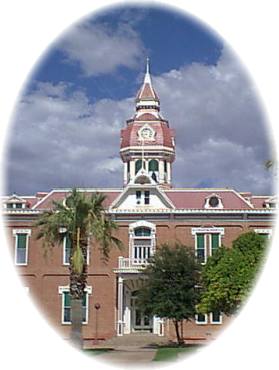

This adobe structure is the first Pinal County Courthouse built in 1877. Listed on the National Register of Historic Places, the courthouse is the historic districts finest example of the Early Transitional Style with verandas running the length of the structure. The original courthouse contained four rooms and five more rooms were added in 1882. Like most buildings in Territorial Arizona, the original 1878 structure was constructed by hand using native materials. Soil from the area was used to make adobe bricks which were laid on a trench foundation filled with river rocks. All lumber for the floors and roof was hauled by wagon from northern Arizona.
The local "Vigilance Committee" stormed the Sheriff's office in this building in 1888, dragged two men from their cells and hanged them in the corridor of the jail. Those two had been charged with holding up a stage and killing Johnny Collins, the guard. A coroner's jury later found that the two prisoners had met their deaths "at the hands of parties unknown/" A short time later, the same "vigilance" group attempted to lynch four other prisoners under the same circumstances but were thwarted in their efforts when Michael Rice, the jailer, armed the prisoners, took them upstairs and faced down the mob from the windows above the street.
Because the second courthouse had been built by 1891, the County turned the building into a hospital, and it was used in this capacity for more than 50 years. It served as a public health and welfare office in 1938, and then a museum run by the Pinal County Historical Society in 1968. The building was sold at public auction in 1972, and purchased by Ernest W. and Edna McFarland. It was then donated to the Arizona State Parks Board for use as a museum. McFarland State Park has been open to the public in the restored courthouse since 1979.
Today, visitors tour the building where they can see and feel for themselves the history of Arizona and the people who helped shape it. While at the park, take a moment to visit the archives to see and read documents from all three branches of government in which "Mac" McFarland served.